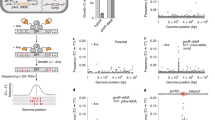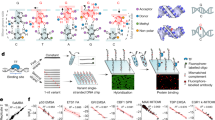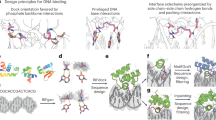Abstract
PUT3 is a member of a family of at least 79 fungal transcription factors that contain a six-cysteine, two-zinc domain called a ‘Zn2Cys6 binuclear cluster’. We have determined the crystal structure of the DNA binding region from the PUT3 protein bound to its cognate DNA target. The structure reveals that the PUT3 homodimer is bound asymmetrically to the DNA site. This asymmetry orients a β-strand from one protein subunit into the minor groove of the DNA resulting in a partial amino acid-base pair intercalation and extensive direct and water-mediated protein interactions with the minor groove of the DNA. These interactions facilitate a sequence dependent kink at the centre of the DNA site and specify the intervening base pairs separating two DNA half-sites that are contacted in the DNA major groove. A comparison with the GAL4–DNA and PPR1–DNA complexes shows how a family of related DNA binding proteins can use a diverse set of mechanisms to discriminate between the base pairs separating conserved DNA half-sites.
This is a preview of subscription content, access via your institution
Access options
Subscribe to this journal
Receive 12 print issues and online access
$259.00 per year
only $21.58 per issue
Buy this article
- Purchase on SpringerLink
- Instant access to full article PDF
Prices may be subject to local taxes which are calculated during checkout
Similar content being viewed by others
References
Axelrod, J.D., Majors, J. & Brandriss, M.C. Proline independent binding of PUT3 transcriptional activator protein detected by footprinting in vivo . Mol. Cell. Biol. 11, 564–567 (1991).
Marczak, J.E. & Brandriss, M.C. Analysis of constitutive and noninducible mutations of the PUT3 transcriptional activator. Mol. Cell. Biol. 11, 2609–2619 (1991).
Siddiqui, A.M. & Brandriss, M.C. The Saccharomyces cerevisiae PUT3 activator protein associates with praline specific upstream activator sequences. Mol. Cell. Biol. 9, 4706–4712 (1989).
Brandriss, M.C. Evidence for positive regulation of the proline utilization pathway in Saccharomyces cerevisiae . Genetics 117, 429–435 (1987).
Brandriss, M.C. & Magasanik, B. Genetics and physiology of proline utilization in Saccharomyces cerevisiae: mutation causing constitutive enzyme expression. J. Bacteriol. 140, 504–507 (1979).
Schjerling, P. & Holmberg, S. Comparative amino acid sequence analysis of the C6 zinc cluster family of transcriptional regulators. Nucleic Acids Res. 24, 4599–4607 (1996).
Gardner, K.H., Anderson, S.F. & Coleman, J.E. Solution structure of the Kluyvemmyces lactis LAC9 Cd2Cys6 DNA-binding domain. Nature Struct. Biol. 2, 898–905 (1995).
Johnston, M. A model fungal gene regulatory mechanism: the GAL genes of Saccharomyces cerevisiae Microbiol. Rev. 51, 458–476 (1987).
Marmorstein, R. & Harrison, S.C. Crystal structure of a PPR1-DNA complex: DNA recognition by proteins containing a Zn2Cys6 binuclear cluster. Genes Dev. 8, 2504–12 (1994).
Liang, S.D., Marmorstein, R., Harrison, S.C. & Ptashne, M. DNA sequence preferences of GAL4 and PPR1: how a subset of Zn2Cys6 binuclear cluster proteins recognize DNA. Mol. Cell. Biol. 16, 3773–3780 (1996).
Marmorstein, R., Carey, M., Ptashne, M. & Harrison, S.C. DNA recognition by GAL4: structure of a protein-DNA complex. Nature 356, 408–414 (1992).
Vashee, S., Xu, H., Johnston, S.A. & Kodadek, T. How do Zn2Cys6 proteins distinguish between similar upstream activation sites? J. Biol. Chem. 268, 24699–24706 (1993).
Robbins, A.H. et al. Refined crystal structure of Cd, Zn metallothionein at 2.0 Å resolution. J. Mol. Biol. 221, 1269–1293 (1991).
Vasak, M., Worgotter, E., Wagner, G., Kagi, J.H. & Wuthrich, K. Metal co-ordination in rat liver metallothionein-2 prepared with and without reconstitution of the metal clusters, and comparison with rabbit liver metallothionein-2. J. Mol. Biol. 196, 711–719 (1987).
Baleja, J.D., Marmorstein, R., Harrison, S.C. & Wagner, G. Solution structure of the DNA-binding domain of Cd2-GAL4 from S. cerevisiae . Nature 356, 405–453 (1992).
Kraulis, P.J., Raine, A.R.C., Gadhavi, P.L. & Laue, E.D. Structure of the DNA binding domain of zinc GAL4. Nature 356, 448–450 (1992).
Timmerman, J. et al. 1H, 15N Resonance assignment and three-dimensional structure of CYP1 (HAP1) DNA-binding domain. J. Mol. Biol. 259, 792–804 (1996).
Walters, K., Dayie, K.T., Reece, R.J., Ptashne, M. & Wagner, G. Structure and mobility of the PUT3 dimer: a DNA pincer. Nature Struct. Biol. 4, 744–750 (1997).
Cohen, C. & Parry, D.A. Alpha-helical coiled coils and bundles: how to design an alpha-helical protein. Proteins 7, 1–15 (1990).
Landschultz, W.H., Johnson, P.F. & Mcknight, S.L. The leucine zipper: a hypothetical structure common to a new class of DNA binding proteins. Science 245, 1759–1764 (1988).
O'Shea, E.K., Klemm, J.D., Kim, P.S. & Alber, T. X-ray structure of the GCN4 leucine zipper, a two stranded parallel coiled-coil. Science 254, 539–544 (1991).
Murre, C., McCaw, P.S. & Baltimore, D. A new DNA binding and dimerization motif in immunoglobulin enhancer binding, daughterless, myoD, and myc proteins. Cell 56, 777–783 (1989).
Jones, N. Transcriptional regulation by dimerization: two sides to an incestuous relationship. Cell 61, 9–11 (1990).
Werner, M.H., Huth, J.R., Gronenborn, A.M. & Clore, G.M. Molecular basis of human 46X,Y sex reversal revealed from the three-dimensional solution structure of the human SRY-DNA complex. Cell 81, 705–714 (1995).
Love, J.J. et al. Structural basis for DNA bending by architectural transcription factor LEF-1. Nature 376, 791–795 (1995).
Schumacher, M.A., Choi, K.Y., Zalkin, H. & Brennan, R.G. Crystal structure of Lacl member, PurR, bound to DNA: minor groove binding by α helices. Science 266, 763–770 (1994).
Lewis, M. et al. Crystal structure of the lactose operon represser and its complexes with DNA and inducer. Science 271, 1247–1254 (1996).
Kim, J.L., Nikolov, D.B. & Burley, S.K. Co-crystal structure of TBP recognizing the minor groove of a TATA element. Nature 365, 520–527 (1993).
Kim, Y., Geiger, J.H., Hahn, S. & Sigler, P.B. Crystal structure of a yeast TBP/TATA-box complex. Nature 365, 512–520 (1993).
Rice, P.A., Yang, S.-W., Mizuuchi, K. & Nash, H.A. Crystal structure of a IHF-DNA complex: a protein-induced DNA U-turn. Cell 87, 1295–1306 (1996).
Werner, M.H., Gronenborn, A.M. & Clore, G.M. Intercalation, DNA kinking, and control of transcription. Science 271, 778–784 (1996).
Hoffman, P. & Schepartz, A. Studies on the half-site spacing specificity of the yeast zinc cluster protein PUT3. Bio. Med. Chem. Lett., in the press.
Schultz, S.C., Shields, G.C. & Steitz, T.A. Crystal structure of a CAP-DNA complex: the DNA is bent by 90°. Science 253, 1001–1007 (1991).
Hegde, R.S., Grossman, S.R., Laimins, L.A. & Sigler, P.B. Crystal structure at 1.7 Å of the bovine papillomavirus-1 E2 DNA-binding domain bound to its DNA target. Nature 359, 505–512 (1992).
Konig, P. & Richmond, T.J. The X-ray structure of the GCN4-bZIP bound to a ATF/CREB site DNA shows the complex depends on DNA flexibility. J. Mol. Biol. 233, 139–154 (1993).
Keller, W., Konig, P. & Richmond, T.J. Crystal structure of a bZIP/DNA complex at 2.2 Å: determinants of DNA specific recognition. J. Mol. Biol. 254, 657–667 (1995).
Ellenberger, T.E., Brandl, C.J., Struhl, K. & Harrison, S.C. The GCN4 basic-region leucine zipper binds DNA as a dimer of uninterrupted α-helices: crystal structure of the protein-DNA complex. Cell 71, 1223–1237. (1992).
Weiss, M.A. et al. Folding transitions in the DNA-binding domain of GCN4 on specific binding to DNA. Nature 347, 575–578 (1990).
O'Neil, K.T., Shuman, J.D., Ampe, C. & Degrade, W.F. DNA-induced increase in the α-helical content of C/EBP and GCN4. Biochemistry 30, 9030–9034 (1991).
Spolar, R.S. & Record, M.T. Coupling of local folding to site-specific binding of proteins to DNA. Science 263, 777–784 (1994).
Halvorsen, Y.-D.C., Nandabalan, K. & Dickson, P.C. LAC9 DNA binding domain coordinates two zinc atoms per monomer and contacts DNA as a dimer. Mol. Cell. Biol. 11, 1777–1784 (1991).
Wray, L.U.J., Witte, M.M., Dickson, R.C. & Riley, M.I. Characterization of a positive regulatory gene, LAC9, that controls induction of the lactose-galactose regulone of Kluyveromyces lactis: structural and functional relationships to GAL4 of Saccharomyces cerevisiae . Mol. Cell. Biol. 7, 1111–1121 (1987).
Giles, N.H. et al. Gene organization and regulation in the qa (quinic acid) gene cluster of Neurospora crassa . Microbiol. Rev., 338–358 (1985).
Huit, L. Molecular analysisof the Neurospora qa-1 regulatory region indicates that two interacting genes control qa gene expression. Proc. Natl. Acad. Sci. USA 81, 1174–1178 (1994).
Patel, V.B., Schweizer, M., Dykstra, C.C., Kushner, S.R. & Giles, N.H. Genetic organization and transcriptional regulation in the qa gene cluster of Neurospora crassa . Proc. Natl. Acad. Sci. USA 78, 5783–5787 (1981).
Reece, R.J. & Ptashne, M. Determinants of binding site specificity among yeast C6 zinc cluster proteins. Science 261, 909–911 (1993).
Hellauer, K., Rochon, M.-H. & Turcotte, B. A novel DNA binding motif for yeast zinc cluster proteins: the Leu3p and Pdr3p transcriptional activators recognize everted repeats. Mol. Cell. Biol. 16, 6096–6102 (1996).
Zhang, L. & Guarente, L. The yeast activator HAP1 - a GAL4 family member - binds DNA in a directly repeated orientation. Genes Dev. 8, 2110–2119 (1994).
Zhang, L. & Guarente, L. The C6 zinc cluster dictates asymmetric binding by HAP1. EMBO J. 15, 4676–4681 (1996).
Aggarwal, A.K. Crystallization of DNA binding proteins with oligonucleotides. Methods: A companion to Methods in Enzymology l, 83–90 (1990).
Kabsch, W. Automatic indexing of rotation diffraction patterns. J. Appl. Crystallogr. 21, 67–71 (1988).
Kabsch, W. Evaluation of single-crystal X-ray diffraction data from a position-sensitive detector. J. Appl. Crystallogr. 21, 916–924 (1988).
Gewirth, D., Otwinowski, Z. & Minor, W. The HKL Version 1.0 manual (Yale University Press, New Haven, Connecticut, 1993).
Furey, W. & Swaminathan, S. PHASES: A program package for the processing and analysisof diffraction data from macromolecules. in Meth. Fnzymology (eds. Carter, C. & Sweet, R.) (Academic Press, Orlando, FL, 1995).
Jones, T.A. A graphics model building and refinement system for macromolecules.J. Appl. Crystallogr. 11, 268–272 (1978).
Brunger, A.T. The free R value: a novel statistical quantity assessing the accuracy of crystal structures. Nature 335, 472–474 (1992).
Brunger, A.T. X-PLOR Manual, Version 3.8. (Yale University Press., New Haven, CT, 1996).
Brunger, A.T., Kuriyan, J. & Karplus, M. Crystallographic R factor refinement by molecular dynamics. Science 235, 458–460 (1987).
Hodel, A., Kim, S.-H. & Brunger, A.T. Model bias in macromolecular crystal structures. Acta. Crystallogr. A48, 851–858 (1992).
Carey, J. Gel retardation Methods Enzymol. 208, 103–117 (1991).
Merritt, E.A. & Murphy, M.E.P. RASTER3D version 2.0: a program for photorealistic molecular graphics. Acta Crystallogr. D50, 869–873 (1994).
Kraulis, P.J. MOLSCRIPT: A program to produce both detailed and schematic plots of protein structures. J. Appl. Crystallogr. 24, 946–950 (1991).
Author information
Authors and Affiliations
Rights and permissions
About this article
Cite this article
Swaminathan, K., Flynn, P., Reece, R. et al. Crystal structure of a PUT3–DNA complex reveals a novel mechanism for DMA recognition by a protein containing a Zn2Cys6 binuclear cluster. Nat Struct Mol Biol 4, 751–759 (1997). https://doi.org/10.1038/nsb0997-751
Received:
Accepted:
Issue date:
DOI: https://doi.org/10.1038/nsb0997-751
This article is cited by
-
The crystal structure of Deg9 reveals a novel octameric-type HtrA protease
Nature Plants (2017)
-
Protein-DNA docking with a coarse-grained force field
BMC Bioinformatics (2012)
-
Orientation-specific signalling by thrombopoietin receptor dimers
The EMBO Journal (2011)
-
Regulation of pentose utilisation by AraR, but not XlnR, differs in Aspergillus nidulans and Aspergillus niger
Applied Microbiology and Biotechnology (2011)
-
Identification of the transmembrane dimer interface of the bovine papillomavirus E5 protein
Oncogene (2001)



